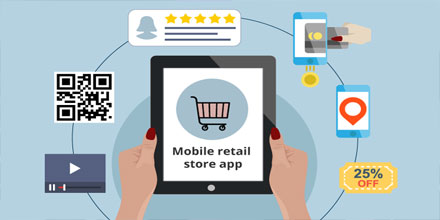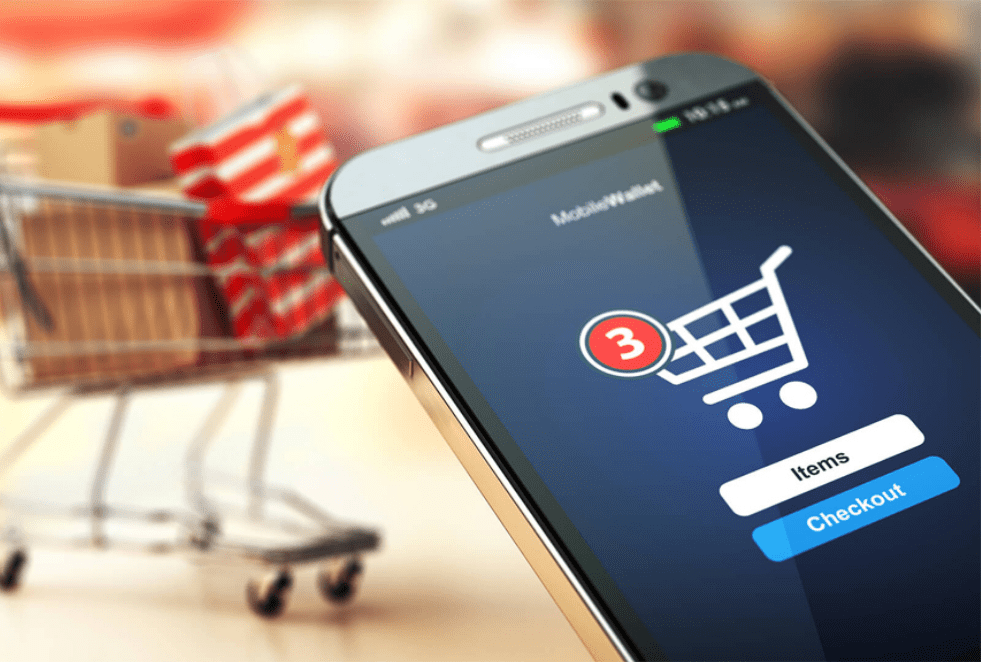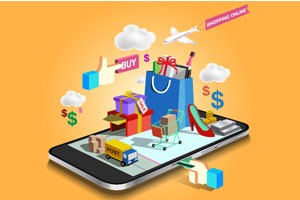The phrase “mobile retailing” refers to buying or doing business via smartphones or tablets. It is now the retail sector’s fastest-growing subsegment in the UK, the US, and Western Europe. Customers have been much more excited about mobile commerce in China and Japan. In Western Europe, mobile commerce increased to 33.9 percent by 2018 from just 6.7 percent of all online sales in 2013.
Some features of mobile apps that may help retailers
Retailers need to include the following crucial aspects within their mobile apps for retail stores in order to remain relevant.
- Swift Response and Registration Procedure
Customers require speedy reactions from the technology they use on this busy day, or else they will switch without even waiting a second. They dislike apps that are sluggish and convoluted with registration or payment processes. The essential e-commerce processes are modernized and automated by mobile applications. A better application enables the safe use of payment information and the seamless completion of online transactions with only one fingertip.
Even the signup process for your mobile commerce application has to be simple and easy. Customers now want complete ease, so a drawn-out, time-consuming registration process will turn them off.
- Multi-payment and Currency Support
The main idea behind making your smartphone a tool for product exploration and sales is to localize your internet company so that it may reach a large user base. A mobile app with support for numerous currencies and payment methods makes localizing your retail operation simple. It’s important to take into account the buyer’s choice and how beneficial the solution is to fulfilling future demands given the variety of approved online payment methods.
- Enabling New Age Push Notifications
Consumers may now choose to get push alerts from retailers on their smartphones and tablets with useful information, offers, and savings. With the opt-in push notification paradigm, merchants give consumers control over the marketing campaigns they wish to see. This is a significant advantage that forces retail mobile applications to in some way live up to user expectations; else, users will carelessly remove your app.
The Key Benefits of having a Mobile App for Retail Business
- Make Online Shopping Simpler
More and more people rely on their smartphones for their purchasing needs. Many customers now use their cell phones as their primary screen while browsing the internet. Nowadays, customers use their mobile phones in various evolving ways while purchasing. On this list are in-store purchases, product reviews, finding new items, and more.
- Enhances Business and Brand Visibility
You can see from the market research data that both business people and regular customers are using mobile devices more and more. These enormous statistics, however, clearly show that there is a full-size market of individuals online who want to use mobile app solutions because of their specialized service offers, even if not all of them are using the apps for the same reasons.
A dedicated store app gives you the opportunity to reach customers in a manner that no other traditional marketing tool can due to the continued use of smartphones.
- Saves Resources and Money on Infrastructure
You will get a higher return on investment with the first choice if you compare the price of developing a retail mobile application with having to pay rent for an offline office or shop. You will also come to the conclusion that marketing and sales efforts for a physical shop are more expensive than those for a mobile app.
- 24×7 Availability and Automated
One of the best benefits of a true mobile application for a retail business is that it helps you run your company around the clock.
With the help of a retail application, you may fully automate your company and stop having to supervise any of the in-person transactions made possible by your website.
With the aid of cutting-edge technology, the automation of your online business application can allow you to provide improved services to the end users. Virtual assistants and automated chatbots are just two examples of technology that may boost both new and recurring revenue.
The top 7 elements to include in your mobile retail app
When developing a mobile app for your retail company, bear in mind that it’s not only an addition to your website that can boost sales—also it’s a resource for customers to locate what they’re looking for fast. Here are the top seven features for mobile retail apps and the reasons both customers and merchants value them.
- Price Check
Price checking is a need since it is the “most desired” function for customers. Because it helps them decide whether or not to buy anything, consumers like knowing how much something costs. The availability of pricing comparison tools makes your company seem more dependable since you are open and honest about your offerings.
- Availability of Item
Whether they enter your business in person or make an online purchase, customers want to be certain that an item is offered for sale. Consumers are more likely to make instant purchases as well as return when the item is in stock if product listings include information that informs them when a certain number of products are remaining, if the item is sold out, or if more goods will be in shortly.
- Comparison Shopping
The process of buying now includes a significant amount of comparison shopping. Customers want to be able to contrast a variety of products offered by your company with those offered by your rivals so they may choose the one they prefer most. Customers are also less inclined to browse other applications or websites when everything is in one location, increasing the likelihood that they’ll make a purchase with you.
- Product Showcases
Customers often visit shops to try out products before buying them to see how they operate or appear. With a product demo, you can completely avoid this. Customers may feel more tempted to “purchase now” if they see a product demo in addition to photographs of the item, its price, and information about whether or not it is in stock.
- Customer Support
Solving problems may be made a lot easier if your mobile app has a customer support component built right in. Customers won’t need to leave the app to look for your phone number or email address this way. They will also appreciate how convenient “click to call” is.
- List of purchases
Customers may gradually locate what they need and compile a list of things that they are interested in by adding a shopping list function to your mobile app. Not to mention, you might suggest that they purchase everything at once or that they buy some of it now and store the rest for later.
- Store Map
A shop map may save customers time, despite the fact that it might not be the most “desired” feature on a mobile app. If your physical store is brand-new or has just undergone remodeling, letting customers know where to locate the items they often purchase can improve their in-store shopping experience. Even though fewer individuals like this function, it could influence whether or not those who do choose to buy with you.
What is m-commerce, or mobile commerce?
The process by which consumers buy products and services using mobile technology is referred to as mobile e-commerce (or m-commerce). You may accomplish this by using your phone to access your favorite retailer’s website or by browsing social media and making a purchase on a site like Pinterest.
Benefits of mobile commerce
Numerous brands that have gone out of business or filed for bankruptcy this year (such as venerable luxury fashion label Henri Bendel, renowned toy store Toys ‘R’ Us, Sears, Claire’s, Brookstone, and more) serve as proof that retail is dead.
What are the advantages of mobile commerce then? Here is what you may anticipate if you decide to take the initial step in converting e-commerce websites into m-commerce ones:
- Accessibility
You can provide your customers with easier access to your goods and services using m-commerce. You may reach them by making your content mobile-friendly and using a responsive design. With mobile e-commerce, you can reach your target market on the platform of their choice. You may raise brand recognition and demonstrate to your consumers that you are aware of how they spend their time by making your business accessible via a mobile commerce platform.
- Intentional audiences
The internet’s ability to connect you with a worldwide audience is one of its most astounding features. By the end of next year, there may be roughly 2.9 billion smartphone users globally, which means that 2.9 billion individuals might access your website. Teenagers in Asia or adults from the Netherlands may both see and buy your goods and services using a mobile device.
This is a really useful tool, particularly for small enterprises that need to be discovered by as many people as possible and are situated in remote locations. You may even grow a following via mobile commerce in a part of the globe you never even considered.
- Business growth and development
You may leverage your newly discovered audiences to grow and improve your company. For instance, you may use mobile e-commerce solutions to conduct A/B testing in a manner similar to your conventional digital marketing approach to determine what sorts of content and/or goods and services are more likely to tickle your clients’ interests while they are using their mobile devices. With such knowledge, you may decide whether to develop or test new aspects of your brand.
- Perfect timing
Brands may schedule their adverts on a variety of mobile commerce platforms, including those for social media and mobile search. You may speak with them during their morning commute, at the gym, over lunch, and even while they are relaxing. By making your content mobile-friendly, you can always connect with your audience, even while they’re on the road.
- Invaluable data
Mobile commerce has several advantages, including the ability to reach clients and audiences you never imagined conceivable and the knowledge you get about your target audience as a result.
Cons of mobile commerce
Mobile commerce undoubtedly provides benefits, but it’s also important to consider the drawbacks before deciding whether or not to enter the realm of mobile e-commerce:
- Privacy issues with data
A brand’s obligation to safeguard customer data increases when it has more access to such data. Users are already upset about Facebook’s handling of user data, so if you’re considering going mobile, you should also be aware of how to handle these concerns for your users.
Get an SSL certificate or utilize well-known organizations like PayPal to process your transactions to make sure your users are secure while visiting your website. Making your customers feel secure when they shop on your website using a mobile device is worth the effort.
- International competition
Although having a global audience sounds incredible, the global competition that comes with it may be difficult. If you decide to launch your business on the mobile commerce market, do so knowing that the nearby boutique apparel shop won’t be your sole rival anymore.
- Internet connectivity
Unfortunately, dealing with internet access is a drawback of becoming mobile. Your website may crash if it experiences an unexpected spike in traffic for which it is unprepared. Make sure your servers are ready in advance to manage the increased bandwidth required by a global audience.
- Transport fees
You need to find a way to deliver your products to the people that purchase them. Setting a minimum for free shipping will motivate your consumers to keep purchasing until they reach the amount that will allow you to justifiably pay the $8.99 shipping label out of your own wallet, helping you to offset the cost of shipping.
- Unknown or unexpected expenses
Unexpected events often occur in business, whether they take place online or on a mobile device. One drawback of mobile commerce, in particular, is the possibility of receiving unexpected charges
This might include everything from global shipping to mobile app maintenance to website upgrades. It’s essential to do research so you can plan and be ready for your mobile rollout at least six months in advance in order to minimize unforeseen charges.
Product Line Retailing
Retailers may also be categorized according to how long and wide their product ranges are. The following retail business types fall under this category:
- Specialist Shop.
- Department Store.
- Supermarket.
- Convenience store
- Superstore
- Combination Store
- Hypermarkets.
The many sorts of retailers may be summarised as follows.
- Specialist Shop
A specialty shop is a retail establishment that specializes in a small range of products yet offers a wide selection of those products. Stores that offer furniture, books, gadgets, flowers, etc. are examples of specialized retailers. Specialty shops may be further categorized based on how limited their product selections are.
- Department Store
A department store is a kind of retail establishment that offers several different product lines. Clothing, household items, and furniture are typical examples of these things. Product lines are administered by specialized buyers or merchandisers as independent departments.
- Supermarket
Supermarkets are big, low-cost, low-margin, high-volume, self-service shops that sell a range of groceries, laundry supplies, and other home goods. Chains of supermarkets often own grocery outlets. The ideas of self-service, customer turnstiles and checkout counters were first introduced by the older supermarkets. Supermarkets first appeared in the 1930s and had decades of rapid growth.
- Convenience Store
The neighborhood convenience shop is a small establishment with extended hours that is open every day of the week. It offers a modest selection of high-demand convenience products. Convenience shops provide a crucial customer demand even if they charge high rates to cover increased operational expenses and lower sales volume.
- Superstore
Superstores are nearly twice as big as typical supermarkets. Superstores sell a wide variety of frequently bought food and non-food goods. They provide services including lunch shops, dry cleaners, post offices, and picture finishing. Because superstores provide a wider selection than traditional supermarkets, their costs are typically 5 to 6 percent higher.
- Combination Store
A combo shop combines a grocery and pharmacy. They are about twice as big as superstores, measuring an average of around one and a half football fields. In the USA, AZP’s Family Mart, Wal Mart’s Supercentres, and Kmart’s Super Centres are a few well-known combo retailers.
- Hypermarkets
Hypermarkets are enormous shops that combine the merchandising of supermarkets, discounts, and warehouses. They sell a variety of products in addition to food, including apparel, furniture, and appliances. Hypermarkets function like warehouses and contain several checkout stations.
During sale hours, forklifts reload shelves by driving along aisles carrying products in wire “baskets” that are piled high on metal racks. Customers that carry their bulky appliances and furnishings out of the shop are given discounts.






